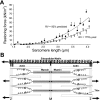Respiratory muscle fiber remodeling in chronic hyperinflation: dysfunction or adaptation?
- PMID: 19359619
- PMCID: PMC2711786
- DOI: 10.1152/japplphysiol.00173.2009
Respiratory muscle fiber remodeling in chronic hyperinflation: dysfunction or adaptation?
Abstract
The diaphragm and other respiratory muscles undergo extensive remodeling in both animal models of emphysema and in human chronic obstructive pulmonary disease, but the nature of the remodeling is different in many respects. One common feature is a shift toward improved endurance characteristics and increased oxidative capacity. Furthermore, both animals and humans respond to chronic hyperinflation by diaphragm shortening. Although in rodent models this clearly arises by deletion of sarcomeres in series, the mechanism has not been proven conclusively in human chronic obstructive pulmonary disease. Unique characteristics of the adaptation in human diaphragms include shifts to more predominant slow, type I fibers, expressing slower myosin heavy chain isoforms, and type I and type II fiber atrophy. Although some laboratories report reductions in specific force, this may be accounted for by decreases in myosin heavy chain content as the muscles become more oxidative and more efficient. More recent findings have reported reductions in Ca(2+) sensitivity and reduced myofibrillar elastic recoil. In contrast, in rodent models of disease, there is no consistent evidence for loss of specific force, no consistent shift in fiber populations, and atrophy is predominantly seen only in fast, type IIX fibers. This review challenges the hypothesis that the adaptations in human diaphragm represent a form of dysfunction, secondary to systemic disease, and suggest that most findings can as well be attributed to adaptive processes of a complex muscle responding to unique alterations in its working environment.
Figures



References
-
- Arnold JS, Thomas GJ, Kelsen SG. Contractile properties of expiratory abdominal muscles: effect of elastase-induce emphysema. J Appl Physiol 62: 2314–2319, 1987. - PubMed
-
- Barreiro E, de la Puente B, Minguella J, Corominas JM, Serrano S, Hussain SNA, Gea J. Oxidative stress and respiratory muscle dysfunction in severe chronic obstructive pulmonary disease. Am J Respir Crit Care Med 171: 1116–1124, 2005. - PubMed
-
- Bellemare F, Cordeau MP, Couture J, Lafontaine E, Leblanc P, Passerini L. Effects of emphysema and lung volume reduction surgery on transdiaphragmatic pressure and diaphagm length. Chest 121: 1898–1910, 2002. - PubMed
-
- Bellemare F, Grassino A. Force reserve of the diaphragm in patients with chronic obstructive pulmonary disease. J Appl Physiol 55: 8–15, 1983. - PubMed
-
- Bellofiore S, Eidelman DH, Macklem PT, Martin JG. Effects of elastase-induced emphysema on airway responsiveness to methacholine in rats. J Appl Physiol 66: 606–612, 1989. - PubMed
Publication types
MeSH terms
Substances
Grants and funding
LinkOut - more resources
Full Text Sources
Medical
Miscellaneous

